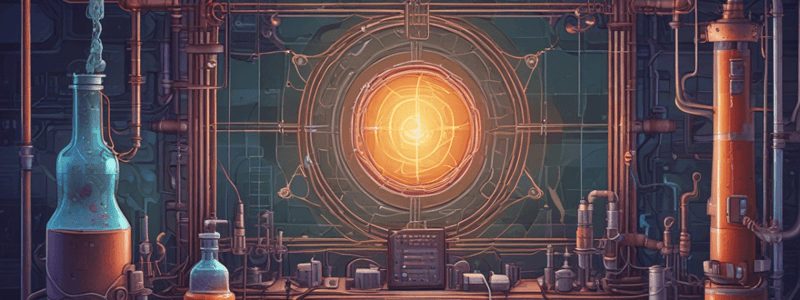Podcast
Questions and Answers
What is the relationship between the mass of ions liberated and the chemical equivalent according to Faraday's second law of electrolysis?
What is the relationship between the mass of ions liberated and the chemical equivalent according to Faraday's second law of electrolysis?
- m ∝ 1/E
- m = constant × E
- m ∝ E (correct)
- m = constant/E
What type of cell has irreversible chemical reactions and cannot be recharged?
What type of cell has irreversible chemical reactions and cannot be recharged?
- Secondary cell
- Lead accumulator
- Dry cell
- Primary cell (correct)
What is the relationship between the electrochemical equivalent and the valency of an ion?
What is the relationship between the electrochemical equivalent and the valency of an ion?
- E = A/V (correct)
- E = V/A
- E = V
- E = A × V
What is the main difference between a primary cell and a secondary cell?
What is the main difference between a primary cell and a secondary cell?
What is the name of the cell that stores electrical energy as chemical energy and can be recharged?
What is the name of the cell that stores electrical energy as chemical energy and can be recharged?
What is the physical quantity that the electrochemical equivalent represents?
What is the physical quantity that the electrochemical equivalent represents?
In a secondary cell, what is the condition for maximum power dissipation in the external circuit?
In a secondary cell, what is the condition for maximum power dissipation in the external circuit?
What is the relationship between the mass of a substance deposited, the electrochemical equivalent, and the electric current in electroplating?
What is the relationship between the mass of a substance deposited, the electrochemical equivalent, and the electric current in electroplating?
What is the purpose of a thermocouple, in terms of heat energy?
What is the purpose of a thermocouple, in terms of heat energy?
What is the term for the ratio of the output power of a cell to the input power, expressed as a percentage?
What is the term for the ratio of the output power of a cell to the input power, expressed as a percentage?
What is the physical significance of the Faraday constant?
What is the physical significance of the Faraday constant?
What is the primary cause of local action in zinc electrodes?
What is the primary cause of local action in zinc electrodes?
What is the purpose of amalgamating zinc rods with mercury?
What is the purpose of amalgamating zinc rods with mercury?
What is the result of polarisation in a voltaic cell?
What is the result of polarisation in a voltaic cell?
What is the electrochemical equivalent of a substance?
What is the electrochemical equivalent of a substance?
What is the relationship between the temperature difference and the heat released or absorbed in Thomson's effect?
What is the relationship between the temperature difference and the heat released or absorbed in Thomson's effect?
What is the unit of Thomson's coefficient?
What is the unit of Thomson's coefficient?
Which of the following effects is observed when a current flows through a conductor with a unit temperature difference?
Which of the following effects is observed when a current flows through a conductor with a unit temperature difference?
What is the direction of heat flow in a positive Thomson's effect?
What is the direction of heat flow in a positive Thomson's effect?
What is the principle behind the working of a thermocouple?
What is the principle behind the working of a thermocouple?
Which of the following metals exhibits a positive Thomson's effect?
Which of the following metals exhibits a positive Thomson's effect?
What is the application of thermopiles?
What is the application of thermopiles?
Which of the following metals shows a positive Thomson's effect?
Which of the following metals shows a positive Thomson's effect?
What is the purpose of a thermopile?
What is the purpose of a thermopile?
What is the Peltier effect used for?
What is the Peltier effect used for?
What is the effect in which a temperature difference between two junctions produces an electric current?
What is the effect in which a temperature difference between two junctions produces an electric current?
What is the effect in which an electric current produces a temperature difference between two junctions?
What is the effect in which an electric current produces a temperature difference between two junctions?
What is the effect in which a temperature difference along a conductor produces a voltage?
What is the effect in which a temperature difference along a conductor produces a voltage?
What is the type of device that uses the Seebeck effect to convert heat into electrical energy?
What is the type of device that uses the Seebeck effect to convert heat into electrical energy?
What is the relationship between the heat produced and the current passing through a junction in the Thomson's effect?
What is the relationship between the heat produced and the current passing through a junction in the Thomson's effect?
Flashcards are hidden until you start studying




